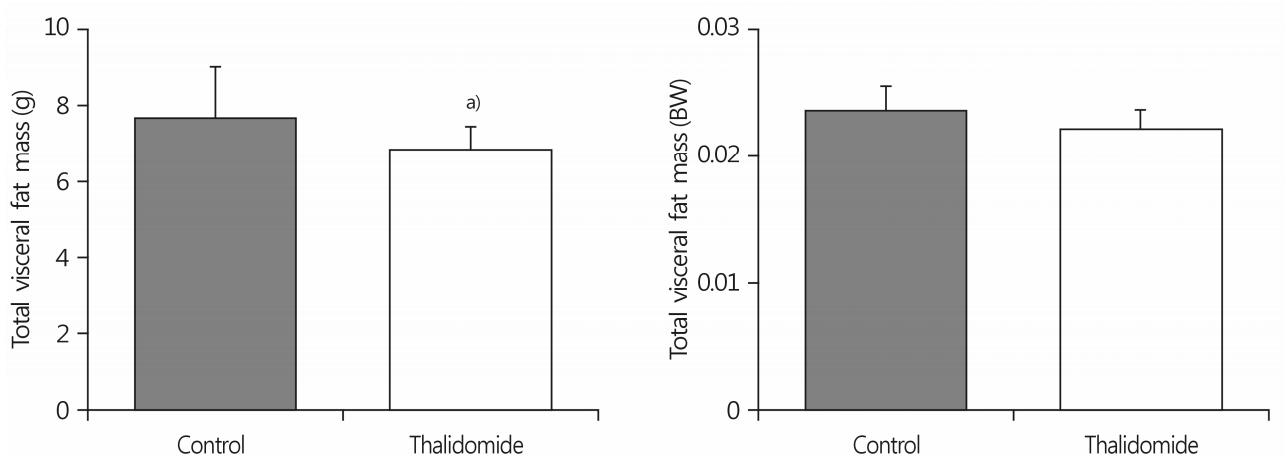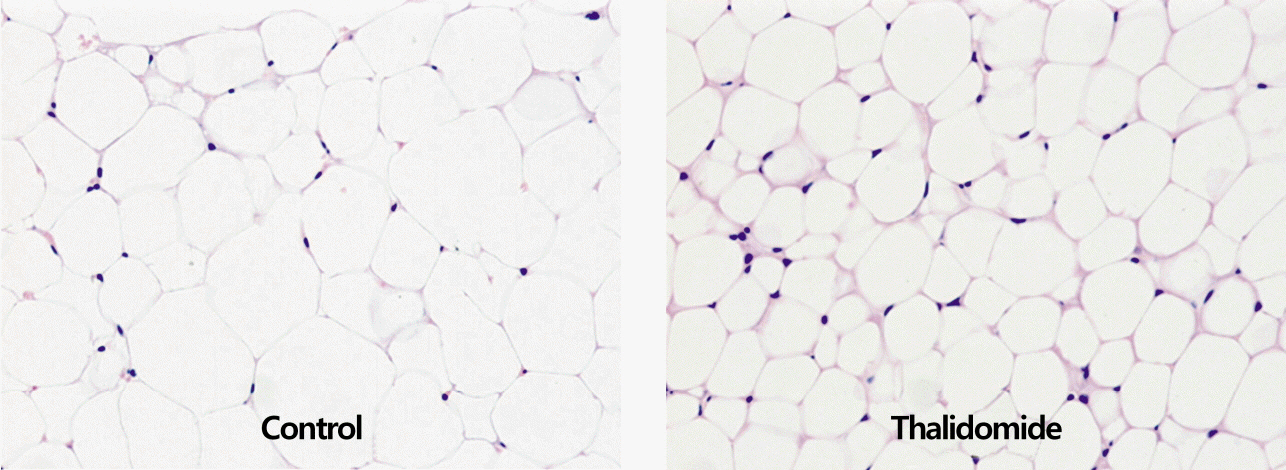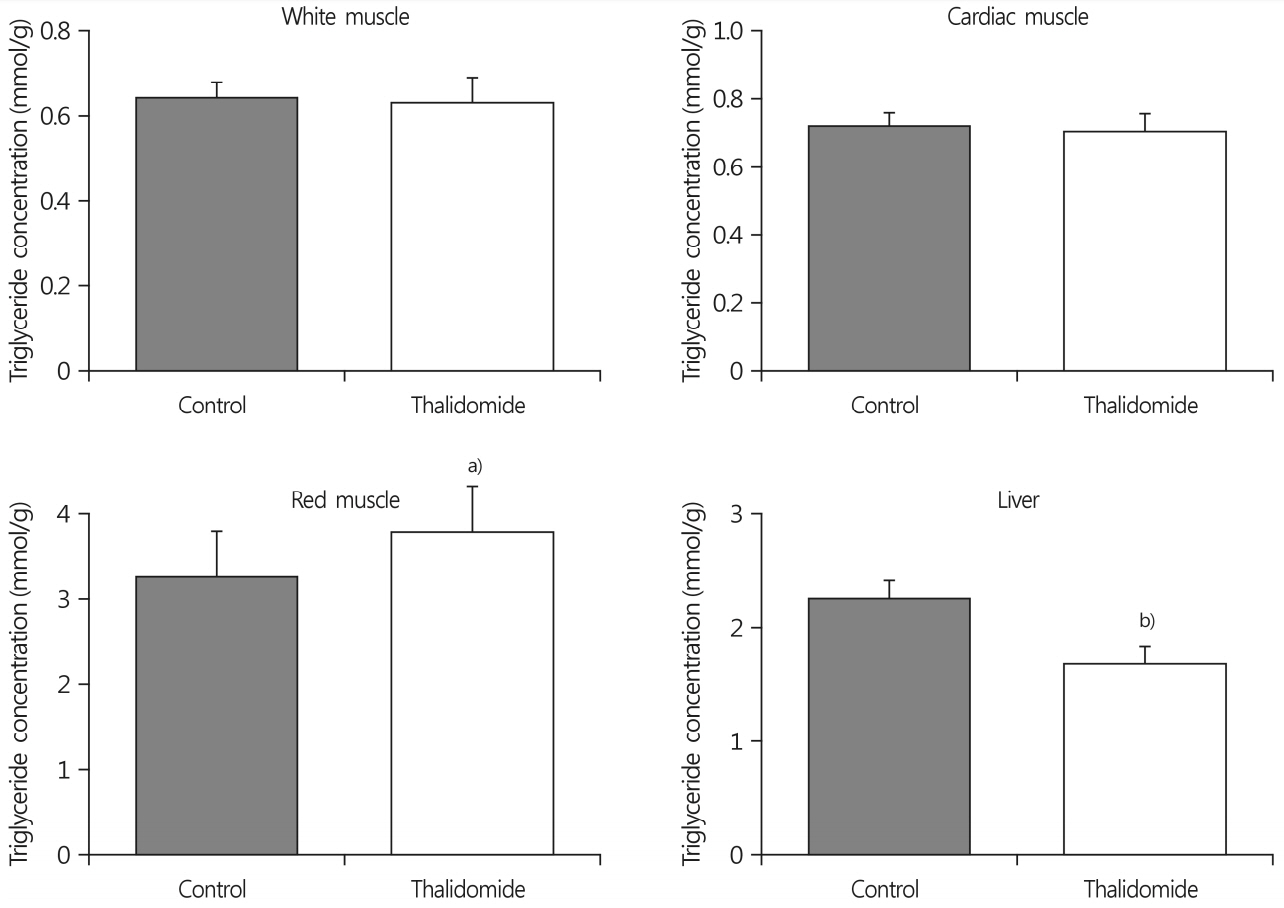Yeungnam Univ J Med.
2018 Dec;35(2):213-218. 10.12701/yujm.2018.35.2.213.
The effect of thalidomide on visceral fat pad mass and triglyceride concentration of the skeletal muscles in rats
- Affiliations
-
- 1Department of Leisure & Sports, Kyungpook National University, Sangju, Korea.
- 2School of Biotechnology, Yeungnam University, Gyeongsan, Korea.
- 3Department of Obesity-Diabetes Advanced Research Center, Yeungnam University, Daegu, Korea. jykim@ynu.ac.kr
- KMID: 2433741
- DOI: http://doi.org/10.12701/yujm.2018.35.2.213
Abstract
- BACKGROUND
Body fats, especially both of abdominal fat pad mass and skeletal muscle fat content, are inversely related to insulin action. Therefore, methods for decreasing visceral fat mass and muscle triglyceride content may be helpful for the prevention of insulin resistance.
METHODS
Thalidomide, used for its anti-angiogenic and anti-inflammatory properties, was administered to rats for 4 weeks. A 10% solution of thalidomide in dimethyl sulfoxide was injected daily into the peritoneal cavity as much as 100 mg/kg of body weight.
RESULTS
The total visceral fat pad mass in the thalidomide-treated group was 11% lower than in the control group. The size of adipocytes of the epididymal fat pad mass in the thalidomide-treated group was smaller than in the control group. The intraperitoneal thalidomide treatment increased triglyceride concentrations by 16% in the red muscle, but not in the white muscle.
CONCLUSION
The results suggested that intraperitoneal thalidomide treatment inhibited abdominal fat accumulation, and that the free fatty acids in the blood were preferentially accumulated in the red muscle rather than in the white muscle.
Keyword
MeSH Terms
Figure
Reference
-
1. Kim JY, Nolte LA, Hansen PA, Han DH, Ferguson K, Thompson PA, et al. High-fat diet-induced muscle insulin resistance: relationship to visceral fat mass. Am J Physiol Regul Integr Comp Physiol. 2000; 279:R2057–65.
Article2. Kim JY, Nolte LA, Hansen PA, Han DH, Kawanaka K, Holloszy JO. Insulin resistance of muscle glucose transport in male and female rats fed a high-sucrose diet. Am J Physiol. 1999; 276:R665–72.3. Jacob S, Machann J, Rett K, Brechtel K, Volk A, Renn W, et al. Association of increased intramyocellular lipid content with insulin resistance in lean nondiabetic offspring of type 2 diabetic subjects. Diabetes. 1999; 48:1113–9.
Article4. Krssak M, Falk Petersen K, Dresner A, DiPietro L, Vogel SM, Rothman DL, et al. Intramyocellular lipid concentrations are correlated with insulin sensitivity in humans: a 1H NMR spectroscopy study. Diabetologia. 1999; 42:113–6.
Article5. D'Amato RJ, Loughnan MS, Flynn E, Folkman J. Thalidomide is an inhibitor of angiogenesis. Proc Natl Acad Sci U S A. 1994; 91:4082–5.6. Yabu T, Tomimoto H, Taguchi Y, Yamaoka S, Igarashi Y, Okazaki T. Thalidomide-induced antiangiogenic action is mediated by ceramide through depletion of VEGF receptors, and is antagonized by sphingosine-1-phosphate. Blood. 2005; 106:125–34.
Article7. Folch J, Lees M, Sloane-Stanley GH. A simple method for the isolation and purification of total lipides from animal tissues. J Biol Chem. 1957; 226:497–509.
Article8. Frayn KN, Maycock PF. Skeletal muscle triacylglycerol in the rat: methods for sampling and measurement, and studies of biological variability. J Lipid Res. 1980; 21:139–44.
Article9. Denton RM, Randle PJ. Concentrations of glycerides and phospholipids in rat heart and gastrocnemius muscles. Effects of alloxan-diabetes and perfusion. Biochem J. 1967; 104:416–22.
Article10. Teo SK, Evans MG, Brockman MJ, Ehrhart J, Morgan JM, Stirling DI, et al. Safety profile of thalidomide after 53 weeks of oral administration in beagle dogs. Toxicol Sci. 2001; 59:160–8.
Article11. Haslett P, Hempstead M, Seidman C, Diakun J, Vasquez D, Freedman VH, et al. The metabolic and immunologic effects of short-term thalidomide treatment of patients infected with the human immunodeficiency virus. AIDS Res Hum Retroviruses. 1997; 13:1047–54.
Article12. Rupnick MA, Panigrahy D, Zhang CY, Dallabrida SM, Lowell BB, Langer R, et al. Adipose tissue mass can be regulated through the vasculature. Proc Natl Acad Sci U S A. 2002; 99:10730–5.
Article13. Fukumura D, Ushiyama A, Duda DG, Xu L, Tam J, Krishna V, et al. Paracrine regulation of angiogenesis and adipocyte differentiation during in vivo adipogenesis. Circ Res. 2003; 93:e88–97.
Article14. Nakamitsu PZ, Compri CM, de Fraia Pinto L, Gotardo ÉM, de Oliveira CC, Ribeiro ML, et al. Thalidomide controls adipose tissue inflammation associated with high-fat diet-induced obesity in mice. Endocr Metab Immune Disord Drug Targets. 2015; 15:151–8.15. Kelley DE, Goodpaster BH, Storlien L. Muscle triglyceride and insulin resistance. Annu Rev Nutr. 2002; 22:325–46.16. Hua N, Takahashi H, Yee GM, Kitajima Y, Katagiri S, Kojima M, et al. Influence of muscle fiber type composition on early fat accumulation under high-fat diet challenge. PLoS One. 2017; 12:e0182430.
Article17. Korach-André M, Gao J, Gounarides JS, Deacon R, Islam A, Laurent D, et al. Relationship between visceral adiposity and intramyocellular lipid content in two rat models of insulin resistance. Am J Physiol Endocrinol Metab. 2005; 288:E106–16.
Article18. Hall JE. Guyton and Hall textbook of medical physiology. 13th ed. Philadelphia: Elsevier;2016. p. 84.
- Full Text Links
- Actions
-
Cited
- CITED
-
- Close
- Share
- Similar articles
-
- Insulin Resistance of Skeletal Muscle was Recovered by Leptin Injection in vivo, but not in vitro, in High-fat Diet Fed Rats
- Effects of Wax Guard on Weight, Triglyceride, Leptin and Fat Cell Size in Rats Fed on a High Fat Diet
- Combined trial of fish oil and exercise training prevents impairment in insulin action on glucose transport of skeletal muscle induced by high-fat diet in rats
- Relative Skeletal Muscle Mass Is Associated with Development of Metabolic Syndrome
- The Correlation between the Triglyceride to High Density Lipoprotein Cholesterol Ratio and Computed Tomography-Measured Visceral Fat and Cardiovascular Disease Risk Factors in Local Adult Male Subjects




